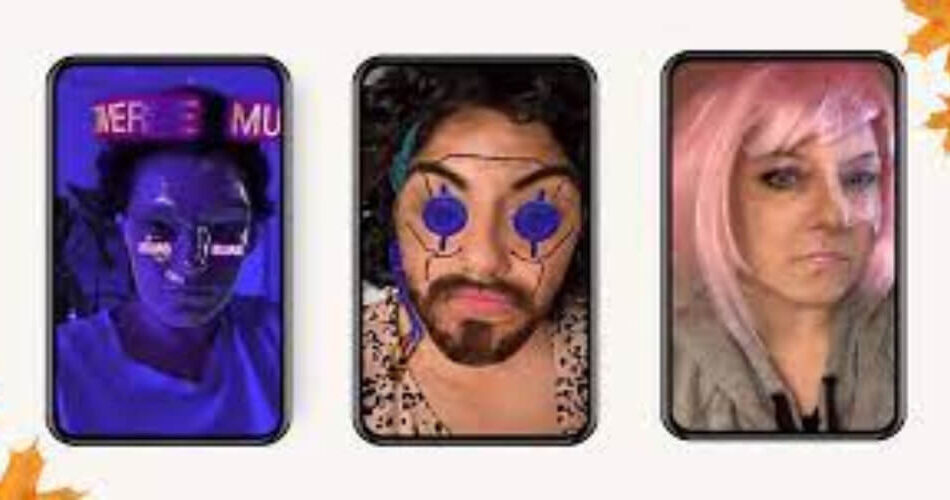Instagram AR filters are an excellent way to engage with your followers and make your content stand out. They are fun, interactive, and can be customized to fit your brand or personal style.
Creating Instagram AR filters may seem daunting, but it’s quite simple when using Spark AR Studio, now rebranded as Meta Spark Studio.
Whether you’re a content creator, business owner, or just someone who loves Instagram, learning how to make AR filters can help you stay ahead of the curve and keep your followers engaged.
Anyone can take advantage of the creative possibilities provided by Instagram AR filters to increase customer engagement.
Ready to bring your ideas to life and create unique AR filters that reflect your personality or brand?
Let’s dive in and explore the world of Instagram AR filters!
Understanding Instagram AR Filters
What Is An Instagram AR Filter?
Instagram AR filters (Augmented Reality Filters) are special effects that are created by a computer and can be superimposed onto real-life pictures or videos. They are accessible through Instagram Stories and Reels, enabling users to merge different layers of visual effects when they use the Instagram App to capture ordinary images.
How Do AR Filters Work On Instagram?
When you use an AR filter, the camera captures your surroundings, and the filter adds a digital layer on top of the image.
The filter then tracks the movement of your face or body, adjusting the digital layer in real-time to create the illusion of seamless integration between the real world and the digital layer.
Creators and brands use Spark AR Studio, a free software platform, to create and publish AR filters. With this tool, users can create custom filters and effects by using a variety of features.
Why Make An Instagram AR Filter?
Creating an Instagram filter has become a great way to connect with audiences and explore trends on Instagram.

It can be used as a tool for brands to express their creativity by customizing features that align with their branding, broadening their reach on Instagram.
In addition to allowing brands to showcase their personality, creating Instagram filters can add impactful visuals that attract more attention and spark conversations among users.
This allows businesses of all sizes to make use of this powerful tool and engage effectively with people who may have not been previously exposed to them.
How To Make Your Instagram Filter Using Spark AR Studio
- Step 1: Download And Install Meta Spark Studio
- Step 2: Open Meta Spark Studio
- Step 3: Create A New Project
- Step 4: Add An Object To The Viewport
- Step 5: Edit The Object In The Scene Panel
- Step 6: Test Your New Instagram AR Filter
- Step 7: Publish Your New Instagram AR Filter
Step 1: Download And Install Meta Spark Studio
To start creating custom filters for Instagram Stories, the first step is to download and install Spark AR Studio.
Currently, it’s available for Mac and Windows. Once downloaded, install the software on your computer.

Step 2: Open Meta Spark Studio
After installation, open Spark AR Studio to get started.
Spark AR Studio provides users with an intuitive interface and a wide range of features to explore, allowing them to create stunning effects for their photos and videos.
Familiarize yourself with the workspace by exploring all the different panels available in it – Scene, Assets, Viewport, Inspector – each offering something unique.
Meta offers sufficient resources to get you started, but if you are interested in pushing your skill further consider this course on Edx.
Step 3: Create A New Project
Once you have opened Spark AR Studio, create a new project. This will take you to the main workspace where you can start designing your filter.
When starting a new project, there are two options available: creating from scratch or using existing templates.
To make things simple we will use an existing template for this guide.
Step 4: Add An Object To The Viewport
Now that you have created a new project, it’s time to add an object to the viewport. This can be done by clicking on the “Add Object” button and selecting the type of object you want to add.
Step 5: Edit The Object In The Scene Panel
After adding an object to the viewport, it’s time to edit it in the Scene Panel. This is where you can adjust the size, position, and other properties of the object to make it look exactly the way you want it to.
Step 6: Test Your New Instagram AR Filter
Once you are satisfied with your filter, it’s time to test it out. Spark AR Studio comes with a built-in testing tool that allows you to see how your filter will look on a real device.
Step 7: Publish Your New Instagram AR Filter
Publishing your new Instagram AR filter is the last step in the process. Once you have tested and tweaked all of the necessary components, it’s time to share your effect with the world!
To publish your effect, click on the ‘upload’ button located at the bottom left-hand corner of the screen. This will trigger Spark AR’s review process to ensure that your effect meets Meta policies and guidelines.
It may take a few days or even up to a week for approval; however, once they approve it, it will be available for users around the globe to experience.
Tips For Making Instagram AR Filters
Creating Instagram AR filters can be a fun and exciting way to engage with your audience. Here are a few tips to keep in mind when making your filters:
- Keep it simple: While it’s tempting to go all out with complex animations and effects, simple filters are often the most effective. Focus on creating a filter that is easy to use and understand.
- Think about your audience: Consider who your target audience is and what type of filter they would enjoy using. For example, if your audience is primarily made up of gamers, you could create a filter that adds game-inspired effects to their photos.
- Test your filter: Before publishing your filter, make sure to test it thoroughly to ensure that it works as intended. Ask friends or colleagues to test it out and provide feedback.
- Use high-quality assets: To create a professional-looking filter, use high-quality images, animations, and 3D models. Poor-quality assets can make your filter look unprofessional and unappealing.
- Stay on brand: Make sure your filter aligns with your brand’s overall aesthetic and messaging. This will help to reinforce your brand identity and make your filter more recognizable.
Examples Of Popular Instagram AR Filters
Instagram AR filters are a great way to increase brand awareness and recognition. Brands have been getting creative with AR filters, and here are some examples of popular filters:
- The Fresh AR Prince filter: This is a throwback to Will Smith’s iconic role as The Fresh Prince of Bel-Air.
- The Super Glow filter: This custom filter was created by Aritzia and has been increasing brand awareness and recognition.
- The ITA Outline filter: This filter was created by UX designer, Javi Perez, and has been popular among Instagram users.
- The Color Adjustment filter: This filter can change the colors of the camera feed in real time and has been very popular.
Instagram AR Filters Wrap Up
Creating Instagram AR filters can seem daunting at first, but with the right tools and resources, anyone can do it.
Spark AR Studio is a user-friendly platform that allows users to create custom filters and effects for Instagram Stories.
The platform offers a variety of features such as adding sound files and 3D objects to the canvas, which can be manipulated to achieve the desired look and interactivity.
Users can quickly learn how to create their filters. They can explore the free library of objects that Spark AR Studio offers or create their own using 3D modeling software.
AR technology has unlocked new possibilities for sharing the richness of life, and Instagram AR filters are a fun and creative way to do so.
With the increasing popularity of AR filters, creating your own can help you stand out and showcase your creativity to your followers.

